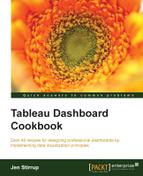We can make the dashboard more effective by highlighting certain aspects of data visualization. Basically, when the user hovers over the data point, it will highlight the column and row where the data point is found. Highlighting the data means that other irrelevant data points are grayed out, thereby emphasizing the relevant data points. This is a useful dashboarding tool because the relevant features are made more prominent, thereby enhancing the speed with which the data is understood.
We can create highlights using the Actions feature in Tableau. To create a highlight action, use the following options:
- For workbooks, we can find an Actions option under the Worksheet menu item.
- When we move towards creating a full dashboard, we can find dashboard actions under the Dashboard menu item. For now, we are looking at creating components that will go onto a dashboard, so we will stick with the worksheet feature for now.
In this recipe, we will use the existing workbook that you created for this chapter.
We will use the same data as before. For this recipe, we will take a copy of the Bins Set Manually worksheet and select the Duplicate Sheet option. You can then rename the sheet to Actions.
- Once you have your worksheet in place, you will need to locate the correct Actions item. To do this, go to the Worksheet menu and look for Actions. You can see an example of this in the following screenshot:

- This will bring up the Actions dialog box. The following is an example:

- In the Actions dialog box, select the Add Action button; this will bring up some options. We will choose the Highlight option.
- Once we have selected the Highlight option, you will see the Edit Highlight Action dialog box appear, which you can see in the next screenshot.
- We will call this
Bin Highlight Action, and it will be based on the Actions worksheet. - We will then choose the Hover option, which you can see on the right-hand side of the Edit Highlight Action dialog box.
- For the Target Highlighting option, select all the fields. The dialog box will then appear, as shown in the following screenshot:

- Click on OK. Now, on the Actions dialog box, again click on OK.
- Go back to the Tableau worksheet. We will change the Tableau worksheet so that we can see the result of the action.
- On the Columns shelf, place the Product Category hierarchy, the SalesAmount Buckets, and the Year(Date) dimension attribute.
- On the Rows shelf, select SUM(SalesAmount). We will place Year(Date) on the Color button.
- Finally, select Discrete (Lines) from the Show Me panel in order to show the patterns over the years for each bucket type. Change the mark type to a shape by going to the drop-down list and selecting the shape. You can see this in the following screenshot:

- If you hover the mouse over one of the bucket names, you will see that the relevant data points are highlighted. In the following example, when we hover the mouse over the 1000 bucket, we can see that it lights up the data points for that bucket; also, the relevant years are highlighted. It's clear that other data points are grayed out.

